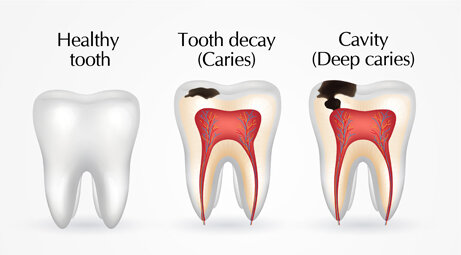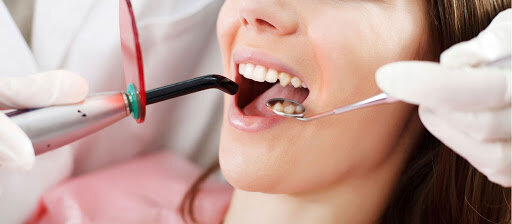Do you want to get rid of your paled and stained teeth. Do you really wish to have a bright smile? If yes, this comprehensive guide could be useful for you.
When it comes to teeth whitening, you mainly have two options; In-Office teeth whitening and At-Homes teeth whitening. Both these options are effective in whitening your teeth. You can choose any of these options depending on your teeth whitening requirements and preferences.
These whitening treatments or procedures excessively use hydrogen peroxide-based bleaching agents, which are the primary teeth whitening chemical. The longer you will keep hydrogen peroxide-based bleaching agent applied on the surface of your teeth, the whiter and brighter teeth you will get. However, suppose this chemical is relatively high; in that case, it is better to keep it over the teeth for a shorter time. It can dehydrate your teeth and trigger tooth sensitivity.
In-office-based teeth whitening treatment contains 15% to 43% hydrogen peroxide, while at-home teeth whitening includes 3% to 20% hydrogen peroxide. It means in-office-based teeth whitening treatment and procedures are more effective than at-home whitening kits.
In-Office Based Teeth Whitening and Bleaching
In-office teeth whitening treatment is performed by whitening dentists in McKinney TX. It is mainly performed in two different ways; ZOOM whitening (sometimes also called laser whitening) and tray bleaching.
ZOOM Whitening- The ZOOM whitening treatment method is the most effective way to whiten and brighten discolored teeth. The dentist does it by using a laser whitening system.
With this teeth whitening method, you can get 5 to 8 shades of whiter and brighter teeth within one or two hours. It is the fastest way to get a shining white smile.
The ZOOM whitening treatment is ideal for those dental patients who want to get immediate whitening results. However, this method is not entirely safe for dental health as it can lead to certain side-effects.
It increases the teeth' temperature, leading to sensitivity issues, and sometimes burns the gums. If you choose this option, it can be risky for you. So, it would be best if you first consult with your concerned dentist.
Tray Bleaching- In-office-based tray bleaching method is the most popular and preferred teeth whitening treatment. In most whitening dental clinics, this method is used as a primary teeth whitening treatment.
While using this method, a whitening dentist uses a combination of custom-made trays and whitening gel. He/she places the whitening gel on the custom-made tray and then perfectly places that tray on the patient's teeth for 30 to 60 minutes. In this period, the peroxide in the gel breaks down, and hydroxy radicals start interacting with the teeth' surface. This process helps in removing the yellowness and stains from the teeth and brings the natural shine to the front.
This in-office-based tray bleaching method can give you eight shades of whiter and brighter teeth. However, for that, you will have to take several 30 to 60 minutes treatment sessions with your whitening dentist.
In-office-based tray bleaching is a perfect teeth whitening treatment for those dental patients who can afford multiple dental office visits with a 30 to 60 minutes treatment session with a whitening dentist.
Tray bleaching has no side-effects if it is done appropriately. You can also perform it at your home at your own convenience.
At-Home Teeth Whitening
At-Home teeth whitening option is especially for those dental patients who prioritize convenience more than anything else. The patient itself performs this type of whitening treatment at its own convenience at home. Sometimes, a patient's friend or family members can perform this teeth whitening procedure to make it convenient.
At-home whitening treatment and procedures can be performed using many different teeth whitening kits and over-the-counter products, such as whitening strips, whitening toothpaste, mouthwash, etc. You can get these teeth whitening kits and over-the-counter products only from whitening dentists. You will not find these products in your local market.
This teeth whitening method involves:
Tray Bleaching
Paint-On Teeth Whiteners
Teeth Whitening Stripes
Teeth Whitening Toothpaste and Mouthwash
Out of these At-Home teeth whitening methods, tray bleaching has been the most effective and fastest teeth whitening solution. If you want to choose At-Home teeth whitening, you should select tray bleaching. It would be the best option for you.
Which Option Should You Choose?
Considering the effectiveness and benefits of an in-office-based whitening solution, it won't be wrong to say that in-office-based whitening treatment is the best option for you. It would be best if you consider it over an at-home teeth whitening kit. However, it also depends on your requirements and preferences.
For example- if you are not convenient with having multiple dental office visits for treatment, in-office-based whitening is not perfect for you. In this type of case, you can opt for at-home whitening treatment.
In the end, we hope this piece of information has been interesting and useful for you. For such more qualitative and informative pieces of reading on dental health, keep in touch with us.






